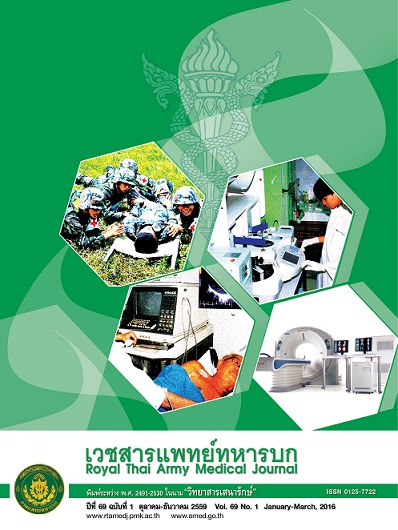อัตราความสำเร็จจากการรักษาด้วยไอโอดีนรังสีในผู้ป่วยไทรอยด์เป็นพิษชนิด Graves’ disease ณ โรงพยาบาลพระมงกุฎเกล้า
Main Article Content
Abstract
ภูมิหลัง: Graves’ disease เป็นสาเหตุสำคัญที่สุดของไทรอยด์เป็นพิษ (thyrotoxicosis) ปัจจุบันมีการรักษาหลายวิธีได้แก่ รักษาด้วยยาต้านไทรอยด์, การผ่าตัด และการใช้ไอโอดีนรังสี โดยการรักษาด้วยไอโอดีนรังสี เป็นที่นิยมกันมากขึ้น เนื่องจากเป็นวิธีที่มีประสิทธิภาพทางการรักษาสูง ปลอดภัย ค่าใช้จ่ายน้อย และภาวะแทรกซ้อนต่ำ I-131 จะให้รังสีเบต้า ซึ่งมีผลทำลายเนื้อเยื่อที่ต่อมไทรอยด์ ส่งผลให้เกิดภาวะขาดฮอร์โมนไทรอยด์ถาวรจึงจำเป็นต้องติดตามการรักษาต่อเนื่อง วัตถุประสงค์: เพื่อหาอัตราความสำเร็จจากการรักษาด้วยวิธีไอโอดีนรังสีในผู้ป่วย Graves’ disease ศึกษาปัจจัยที่มีผลต่อการรักษาด้วยวิธีไอโอดีนรังสี และหาอัตราการเกิดภาวะขาดฮอร์โมนไทรอยด์ชั่วคราว (transient hypothyroid) และอัตราการเกิดภาวะขาดฮอร์โมนไทรอยด์ถาวร (permanent hypothyroid) วัสดุและวิธีการ: เก็บข้อมูลจากเวชระเบียนของผู้ป่วยที่เป็นโรค Graves’ disease จำนวน 121 ราย ที่เข้ามารับการรักษาด้วยวิธีไอโอดีนรังสี ที่แผนกเวชศาสตร์นิวเคลียร์ กองรังสีกรรม โรงพยาบาลพระมงกุฎเกล้า ตั้งแต่ช่วงเวลา มกราคม 2551 ถึง กุมภาพันธ์ 2554 ผลการศึกษา: อัตราความสำเร็จที่ 2 ปีหลังการรักษาด้วยวิธีไอโอดีนรังสีในผู้ป่วย Graves’ disease เท่ากับ 121 (100%) โดยแบ่งเป็น hypothyroid 114 ราย (94.2%) และ euthyroid 7 ราย (5.8%) ซึ่งแบ่งเป็นกลุ่มที่ได้รับการรักษาด้วย I-131 เพียงครั้งเดียว 72 ราย (59.5%) ได้รับ I -131 ซ้ำเป็นครั้งที่สอง จำนวน 42 ราย (34.7%) และได้รับ I -131 ครั้งที่สาม อีก 7 ราย (5.8%) ปัจจัยที่มีผลต่อการรักษาโรค Graves’ disease ด้วยวิธีไอโอดีนรังสีคือขนาดต่อมไทรอยด์ โดยกลุ่มที่ประสบความสำเร็จหลังการรักษาด้วย I-131 มีขนาดต่อมไทรอยด์ที่เล็กกว่ากลุ่มที่ล้มเหลวหลังการรักษาด้วย I-131 เพียงครั้งเดียว (ขนาดต่อมไทรอยด์เฉลี่ย 52.08±20.82 กรัม และ 66.12±25.23 กรัม ตามลำดับ, p-value <0.001) ส่วนปัจจัยด้านเพศ อายุ ปริมาณไทรอยด์อัพเทคที่ 24 ชั่วโมง ปริมาณ I-131 ต่อน้ำหนักของต่อมไทรอยด์ (µCi /gm) การได้รับยาต้านไทรอยด์มาก่อน และอาการตาโปน ไม่มีความแตกต่างกันอย่างมีนัยสำคัญทางสถิติ ระหว่างกลุ่มที่ประสบความสำเร็จกับกลุ่มที่ล้มเหลวหลังการรักษาด้วย I-131 เพียงครั้งเดียว อัตราการเกิดภาวะ transient hypothyroid มีจำนวน 4 ราย (3.3%) อัตราการเกิดภาวะ permanent hypothyroid ที่ 6 เดือน, 1 ปี, 1 ปี 6 เดือน และ 2 ปี คือ 67%, 81%, 87% และ 94% ตามลำดับ สรุป: การรักษาผู้ป่วย Graves’ disease ด้วย I -131 ด้วยวิธี calculated dose ด้วยขนาดปานกลาง และขนาดสูง เป็นวิธีที่มีประสิทธิภาพ มีอัตราการหายจากไทรอยด์เป็นพิษสูง โดยผู้ป่วยส่วนมากจะหายจากโรคภายใน 1 ปี ส่วนปัจจัยหลักที่มีผลต่อความล้มเหลวทางการรักษาคือ ขนาดต่อมไทรอยด์ที่ใหญ่ อย่างไรก็ตามการรักษาด้วย I-131 มีอัตราการเกิดภาวะขาดไทรอยด์ฮอร์โมนอย่างถาวรสูง และผู้ป่วยบางรายอาจมีภาวะขาดฮอร์โมนไทรอยด์ชั่วคราว ผู้ป่วยทุกรายจำเป็นต้องเฝ้าติดตามผลการรักษาอย่างต่อเนื่อง เพื่อป้องกัน และรักษาภาวะขาดฮอร์โมนไทรอยด์
Success rate of radioiodine therapy in Graves’ disease at Phramongkutklao Hospital
Background: Graves’ disease is the most common cause of hyperthyroidism. The treatment of hyperthyroidism includes antithyroid drug, surgery and radioiodine therapy. Radioiodine therapy (I-131) has become widely used due to its inexpensiveness, high effectiveness and high success rate. Administration of the radioiodine results in destruction of the thyroid tissue. This causes most patients to develop hypothyroidism after therapy and additional long term follow up becomes necessary. Objective: To assess the success rate of radioiodine therapy in Graves’ disease and evaluate the influencing factors. To assess the rate of permanent hypothyroidism and transient hypothyroidism after radioiodine therapy. Methodology: This is a retrospective study of 121 patients with Graves’ disease who received radioiodine therapy in the nuclear medicine department at Phramongkutklao Hospital between January 2008 and February 2011. Results: From the total of 121 patients (80 women and 41 men) with Graves’ disease who received I-131, all of them (100%) were in remission (turn to euthyroid or hypothyroidism) within 2 years after the treatment. 114 patients (94.2%) had hypothyroid and 7 patients (5.8%) had euthyroid. The success rate in single dose I-131 therapy was 59.5%, second dose 34.7% and third dose 5.8%. The factor that influenced the outcome of the treatment was the thyroid gland size. Mean of thyroid gland size in patients with successful treatment of I-131 was lower than patients with failure treatment of I-131 (52.08±20.82 vs 66.12±25.23 gm, p-value <0.001). The other factors including gender, age, 24 hour uptake, dose I-131 to thyroid gland size (µCi /gm), pretreatment with antithyroid drugs and ophthalmopathy, show no significant correlations with success rates. The incidence rate of transient hypothyroid was 3.3% and permanent hypothyroid at 6 months, 12 months, 18 months and 2 years after treatment were 67%, 81%, 87% and 94%, respectively. Conclusion: High success rate and effectiveness in treatment of Graves’ disease after radioiodine therapy with calculated medium to high dose protocol were found. Most patients were successfully treated within 1 year after the treatment. However, most of them develop permanent hypothyroidism and need long term follow up for hormone supplementation. The size of the thyroid gland has an influence on rate of treatment failure; whereby the larger the thyroid gland, the higher the rate of treatment failure.

